
News Archive
| 2024 | 2023 | 2022 | 2021 | 2020 | 2019 | 2018 | 2017 | 2016 | 2015 | 2014 | 2013 | 2012 | 2011 | 2010 |
| December | November | October | September | August | July | June | May | April | March | February | January |
2009-11-30: 2009 Essen Motorshow report and slideshow ...
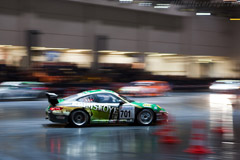 This weekend the annual Essen Motorshow kicked off in the massive Messe 'exhibition centre' in the German city. Originally centred around racing, it has gradually evolved into a tuner show. Usually there are enough gems amidst the massive wheels, ridiculous body-kits and scissor doors to warrant a visit. This year however the Essen Motorshow suffered noticeably from the economic downturn with virtually no manufacturers willing or able to cough up sufficient Euros for space on the floor. This gave the organisers no other choice but to close down one of the biggest halls of the venue. One of the other halls was reserved for a small track where the latest racing cars were demonstrated.
This weekend the annual Essen Motorshow kicked off in the massive Messe 'exhibition centre' in the German city. Originally centred around racing, it has gradually evolved into a tuner show. Usually there are enough gems amidst the massive wheels, ridiculous body-kits and scissor doors to warrant a visit. This year however the Essen Motorshow suffered noticeably from the economic downturn with virtually no manufacturers willing or able to cough up sufficient Euros for space on the floor. This gave the organisers no other choice but to close down one of the biggest halls of the venue. One of the other halls was reserved for a small track where the latest racing cars were demonstrated.Taking centre stage were the dedicated tuning companies, led by Brabus, who had one of the biggest stands of the show. They showcased their new Mercedes-Benz E-Series based B63 S as well as the limited edition, 788 bhp EV12 'One of Ten'. Another world premier was the new 9ff Speed9, which is a tribute to the great Porsche Speedsters of the 1950s. Of the mainstream manufacturers only Abarth, Alfa Romeo and Skoda were present and they did not bring any new stuff. For us the highlights of the show were big displays focused on Ferrari and Lotus racing cars, and a row of recent concept cars. Among the Ferraris was a prime example of the 410 Superamerica, which possessed more style and elegance than most of the cars around it combined. We roamed through the halls in Essen on the opening morning and have captured the interesting, the odd and the outlandish in our exclusive 100-shot gallery. The show is still open to the public until Sunday and there are just enough highlights to warrant a visit. |
2009-11-26: Ferrari 400 Superamerica Cabriolet up close and personal and the Gordini Twingo revealed ...
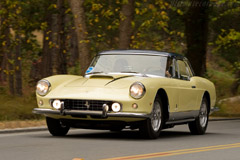 Introduced in January of 1960, the Ferrari 400 Superamerica was a fresh design for a new decade. In many respects the exclusive Grand Tourer was an enlarged 250 GT. The engine was of a similar design but displaced just under 4-litre and produced a claimed 340 bhp. Coach-builder Pininfarina offered the choice of an open and a closed body yet due to the many customisation options no two were ever alike. The very aerodynamic Coupe was the most popular option but most of the early cars sported the Cabriolet body found on our feature cars. It is believed only six or seven Series 1 chassis were fitted with this design and our article is illustrated with shots of three of them. Among them is the actual car that was shown in Brussels. We caught up with this car some years ago at the sole New York City Concours d'Elegance. The other two are pictured at Pebble Beach in 2008 and 2009 respectively. The most recently captured 400 Superamerica will be offered at RM Auctions' inaugural Sporting Classics of Monaco sale in May 2010.
Introduced in January of 1960, the Ferrari 400 Superamerica was a fresh design for a new decade. In many respects the exclusive Grand Tourer was an enlarged 250 GT. The engine was of a similar design but displaced just under 4-litre and produced a claimed 340 bhp. Coach-builder Pininfarina offered the choice of an open and a closed body yet due to the many customisation options no two were ever alike. The very aerodynamic Coupe was the most popular option but most of the early cars sported the Cabriolet body found on our feature cars. It is believed only six or seven Series 1 chassis were fitted with this design and our article is illustrated with shots of three of them. Among them is the actual car that was shown in Brussels. We caught up with this car some years ago at the sole New York City Concours d'Elegance. The other two are pictured at Pebble Beach in 2008 and 2009 respectively. The most recently captured 400 Superamerica will be offered at RM Auctions' inaugural Sporting Classics of Monaco sale in May 2010.A few weeks ago Renault released a teaser image of the first of their new Gordini badged machines. Yesterday the virtual wraps were finally taken off the Twingo Gordini R.S., which will hit the showrooms early next year. A look through the attached press-release revealed that the new Gordini Twingo uses the exact same running gear as the existing Twingo Sport 133. So for now the Gordini badge only provides additional trim. It is nevertheless a very attractive little machine. |
|
2009-11-24: All new BMW 5-Series, Cadillac CTS Coupe, 9ff Speed9 and Bufori racing car ...
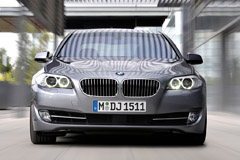 At a ceremony in Munich last night, BMW launched the sixth generation 5-Series. In more ways than one, it is a scaled down version of the 7-Series launched a year earlier. The two luxury sedans have a similar chassis and boast the same styling language. Compared to its class rivals the new 5-Series has the longest wheelbase. A variety of engines will be available for the standard model, topped by the 4.4 litre, direct-injected, twin-turbocharged V8, which powers the 550i. The BMW Motorsport department is already working on the new M5, which is expected to use a further developed version of the 550i's V8.
At a ceremony in Munich last night, BMW launched the sixth generation 5-Series. In more ways than one, it is a scaled down version of the 7-Series launched a year earlier. The two luxury sedans have a similar chassis and boast the same styling language. Compared to its class rivals the new 5-Series has the longest wheelbase. A variety of engines will be available for the standard model, topped by the 4.4 litre, direct-injected, twin-turbocharged V8, which powers the 550i. The BMW Motorsport department is already working on the new M5, which is expected to use a further developed version of the 550i's V8.After a very difficult time, General Motors is ready to look ahead. At the upcoming Los Angeles Auto Show subsidiary Cadillac will unveil the CTS Coupe. Like its four-door siblings, the new coupe uses a direct-injected V6 engine that produces 304 bhp but also great consumption figures. Whether a high performance 'V' version will be added to the line-up is not certain yet. The CTS Coupe will be available in the Spring of 2010 as a 2011 model. This coming Saturday the annual tuner and motorsport extravaganza that is the Essen Motor Show will open its doors for the public. One of the star attractions will no doubt be this 9ff Speed9. Using a Porsche 997 Turbo Cabriolet as a basis, the German tuner created a modern-day version of the legendary Speedster model. In 9ff terms, the 650 bhp produced by the tweaked engine is modest but it suits the car. Customers can order a complete Speed9 or send their own car in for a conversion. Earlier this week we reported on the upcoming Bufori CS road car and now word has reached us that the Bufori BMS R1 competition version successfully competed in this weekend's Macau GT Cup event. Built in less than 10 weeks, the R1 was driven in the event by former F1-racer Alex Yoong. Starting in 28th, he was up to 23rd when debris picked from the track caused his throttle to stick open, resulting in a close encounter with the barriers. The racing car will be further developed at Sepang and the road car is expected to make its official debut at the Beijing Show in 2010. |
2009-11-22: Supercar Sunday and Race Car Round-Up ...
 Every year several new supercar projects are launched but only very few come to fruition. Today we take a closer look at three that have made it beyond the paper phase. From Canada comes the spectacular Pl�thore LC-750, which incorporates a McLaren F1-style centre-seat driving position. Using a supercharged, 750 bhp Corvette sourced engine and a carbon fibre chassis and body, it ticks all the supercar boxes. A 1300 bhp engine is optional, which would make speeds of well in excess of 400 km/h possible. The base LC-750 was first shown at the recent SEMA show and first deliveries can be expected in 2010.
Every year several new supercar projects are launched but only very few come to fruition. Today we take a closer look at three that have made it beyond the paper phase. From Canada comes the spectacular Pl�thore LC-750, which incorporates a McLaren F1-style centre-seat driving position. Using a supercharged, 750 bhp Corvette sourced engine and a carbon fibre chassis and body, it ticks all the supercar boxes. A 1300 bhp engine is optional, which would make speeds of well in excess of 400 km/h possible. The base LC-750 was first shown at the recent SEMA show and first deliveries can be expected in 2010.Arash Farboud has been responsible for various new supercar models and brands over the last few years. He latest creation is the Arash AF-10. This two-seater coupe also combines a readily available Corvette engine with a carbonfibre tub. The styling is somewhat reminiscent of Ferrari's Enzo. Although not a supercar like the first two cars, we could not ignore the Bufori CS, which was launched at Macau over the weekend. Not much is known yet about the Malaysian sports car other than that it will have a carbon fibre body and a turbo-charged four cylinder engine. With the 2009 racing series hardly concluded, it is already time to look ahead to next year. Among the most interesting sports car news of recent weeks was that the Courage-Oreca FLM09 will be eligible for all races of the Le Mans Series and the ALMS. Used this year in a one-make championship, the Corvette engined prototypes will hopefully attract interested gentleman racers into the two series, who don't want to compete the big teams in the existing classes. Porsche faced very stiff competition in the GT3 championships around the world from the new Alpina B6s and Audi R8s. To give its customers a fighting chance, the brand new 997 GT3 R was developed. Using the latest 4-litre engine, it packs 30 bhp more than its predecessor. In 2010 the hotly contested S2000 class can welcome the Ford Fiesta S2000. Built by M-Sport, alongside the WRC Focus, the new Fiesta is powered by a 280 bhp 2-litre engine. Among the first races on the calendar of the small Ford is the Rallye Monte Carlo in January. |
|
2009-11-19: Cooper's rise to power fifty years ago and this year's championship winning Brawn ...
 On December 12th 1959 Jack Brabham pushed his Cooper T51 across the line at Sebring for a fourth place finish in the United States Grand Prix. That gave the Australian enough points to win his first World Championship. It also secured the Constructor's Championship for the Cooper team. History was written that day as it was the first World Championship for a mid-engined car as well as the first time a customer engine beat major manufacturers the likes of Ferrari and Maserati. Cooper's revolution had immediate effect as no other front-engined machine ever won the championship again. The T51 represented the fourth evolution of the single seater introduced halfway trough 1956. The lack of a proper engine prevented the team to compete in Formula 1 on a relatively level playing field until 1959. This was finally made possible by the arrival of a 2.5 litre version of the Climax engine, which proved to be the final piece of the puzzle. Today we celebrate Cooper's revolution and Brabham's heroic efforts at Sebring with a detailed look at the highly influential Cooper T51 Climax.
On December 12th 1959 Jack Brabham pushed his Cooper T51 across the line at Sebring for a fourth place finish in the United States Grand Prix. That gave the Australian enough points to win his first World Championship. It also secured the Constructor's Championship for the Cooper team. History was written that day as it was the first World Championship for a mid-engined car as well as the first time a customer engine beat major manufacturers the likes of Ferrari and Maserati. Cooper's revolution had immediate effect as no other front-engined machine ever won the championship again. The T51 represented the fourth evolution of the single seater introduced halfway trough 1956. The lack of a proper engine prevented the team to compete in Formula 1 on a relatively level playing field until 1959. This was finally made possible by the arrival of a 2.5 litre version of the Climax engine, which proved to be the final piece of the puzzle. Today we celebrate Cooper's revolution and Brabham's heroic efforts at Sebring with a detailed look at the highly influential Cooper T51 Climax.This year's Formula 1 season also saw a new team take home the trophies at their first attempt. News of a Mercedes-Benz take-over earlier this week also means it was Brawn GP's only attempt. Their Mercedes-Benz engined BGP001 propelled Jenson Button to six wins in the opening seven races. Rubens Barrichello added two more victories during the team's fairytale season. For most of the pre-season, it looked like there would be no team at all after Honda had announced its withdrawal from Formula 1 at the end of 2008. Team principal Ross Brawn eventually found enough funding to take over the team and just a few weeks ahead of the first Grand Prix the BGP001 was rolled out. It immediately impressed during testing and Button and Barrichello caused a major upset by finishing first and second at the team's debut. The BGP001 was the big star of the most surprising Formula 1 season in many years. As a 'Silver Arrow', Brawn will enter the 2010 season with two new drivers as Barrichello and Button will move to Williams and McLaren respectively next year. It will be very interesting if the impressive form can be maintained. |
2009-11-16: Ferrari F40 LM and Mercedes-Benz CLK-LM; two very different GT1 cars and two 1970 F1 cars ...
 Although the Ferrari F40 LM was developed by Michelotto in the late 1980s, it was not seriously raced in Europe until half a decade later. The arrival of the GT1 class and the BPR Championship finally provided the racing F40 with a podium to shine on. Its closest competition was the brand new McLaren F1 GTR but the Ferrari nevertheless proved hugely competitive. One of our feature cars won a BPR race in 1995 and finished 12th at Le Mans. For 1996 Michelotto developed an even wilder 'GTE' version of the F40, which was even more competitive and often outpaced the McLarens. A year later both the Ferrari and McLaren faced purpose-built racing cars from Porsche and Mercedes-Benz and gradually lost touch. The ultimate development of these GT1 machines was the Mercedes-Benz CLK-LM that was used in the second half of the 1998 season. Although it failed at Le Mans, the V8-engined racer won all subsequent rounds of the FIA GT Championship. It very effectively killed off the GT1 class that very briefly saw the world's finest supercars go head-to-head. Both the F40 LM and CLK-LM are pictured earlier this year during the Modena Trackdays.
Although the Ferrari F40 LM was developed by Michelotto in the late 1980s, it was not seriously raced in Europe until half a decade later. The arrival of the GT1 class and the BPR Championship finally provided the racing F40 with a podium to shine on. Its closest competition was the brand new McLaren F1 GTR but the Ferrari nevertheless proved hugely competitive. One of our feature cars won a BPR race in 1995 and finished 12th at Le Mans. For 1996 Michelotto developed an even wilder 'GTE' version of the F40, which was even more competitive and often outpaced the McLarens. A year later both the Ferrari and McLaren faced purpose-built racing cars from Porsche and Mercedes-Benz and gradually lost touch. The ultimate development of these GT1 machines was the Mercedes-Benz CLK-LM that was used in the second half of the 1998 season. Although it failed at Le Mans, the V8-engined racer won all subsequent rounds of the FIA GT Championship. It very effectively killed off the GT1 class that very briefly saw the world's finest supercars go head-to-head. Both the F40 LM and CLK-LM are pictured earlier this year during the Modena Trackdays.In 2010 four new teams look set to join Formula 1, which is in part made possible by the readily available Cosworth V8 engine. It is a repeat of the 1970 season when a host of new manufacturers tried their luck at Formula 1 with a car built around the Cosworth DFV engine. The most successful of these was March, who aimed at selling their new 701 at customers. Among them was Ken Tyrrell, who entered his Marches for World Champion Jackie Stewart. The Scot scored three pole positions and won one race in 'his' 701 before switching to the first Tyrrell. Our extensive gallery features four of eleven 701s built, including the example used by Stewart. A little less fortunate was DeTomaso's efforts with the Dallara built and Frank Williams run 505. The car was too heavy and Williams' lead driver Piers Courage suffered a fatal crash. One of the surviving chassis has recently been fully restored by Hall & Hall and was driven up the hill at the most recent Festivals of Speed. For 1971 Williams switched to a March 701, which is also featured in our article. |
|
2009-11-13: McLaren's last Can-Am car and Porsche's sole Works challenger in 1973 ...
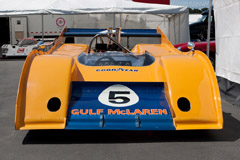 Although officially known as the Canadian American Challenge Cup, the Can-Am series was known for years as the 'Bruce and Denny Show'. That was a reference to the absolute domination by Team McLaren and its drivers Bruce McLaren and Denny Hulme. The arrival of Porsche's turbocharged 917/10K in 1972 finally brought an end to five seasons of domination. Clearly 'outresourced', McLaren did not go down without a proper fight. Gordon Cuppock developed the M20, which was the first all new McLaren Can-Am car since 1968. Following contemporary F1 design, it featured side-mounted radiators, focusing all the weight around the centre of gravity of the car. In pre-season testing the M20 shattered all its predecessors' lap records. Very light and relatively nimble, the new McLaren at times managed to keep up with the turbocharged Porsche 917s, which had an additional 200 bhp on tap. Early in the season Denny managed to score two wins with the M20 but he could not challenge George Follmer for the remainder of the year. McLaren withdrew from Can-Am at the end of the year. Two years after Denny's last win, an M20 fittingly took Can-Am's final win. Earlier this year we caught up with one of the three M20s built for Team McLaren in 1972.
Although officially known as the Canadian American Challenge Cup, the Can-Am series was known for years as the 'Bruce and Denny Show'. That was a reference to the absolute domination by Team McLaren and its drivers Bruce McLaren and Denny Hulme. The arrival of Porsche's turbocharged 917/10K in 1972 finally brought an end to five seasons of domination. Clearly 'outresourced', McLaren did not go down without a proper fight. Gordon Cuppock developed the M20, which was the first all new McLaren Can-Am car since 1968. Following contemporary F1 design, it featured side-mounted radiators, focusing all the weight around the centre of gravity of the car. In pre-season testing the M20 shattered all its predecessors' lap records. Very light and relatively nimble, the new McLaren at times managed to keep up with the turbocharged Porsche 917s, which had an additional 200 bhp on tap. Early in the season Denny managed to score two wins with the M20 but he could not challenge George Follmer for the remainder of the year. McLaren withdrew from Can-Am at the end of the year. Two years after Denny's last win, an M20 fittingly took Can-Am's final win. Earlier this year we caught up with one of the three M20s built for Team McLaren in 1972.With McLaren gone in 1973, the sole remaining challenger for the all conquering Roger Penske entered Porsches was the Shadow team. During previous seasons, the all-black machines only really stood out due to their unusual designs, which always looked fantastic on pape. By employing British designer Tony Southgate some much needed convention arrived at the Don Nicholls run team. Southgate's first Can-Am design for Shadow was the DN2. In an attempt to match the Porsche's for power our feature car is fitted with a twin-turbocharged version of Chevrolet's big block engine. Sadly it never was close to reliable and the naturally aspirated version was blasted out of the water by the latest Porsches. With turbos virtually banned, Shadow won all but one race in 1974 with the DN4, which was a development of the DN2. |
2009-11-11: The first Alfa Romeo Grand Prix racer, Gordini reborn, first look at the new Volvo S60 ...
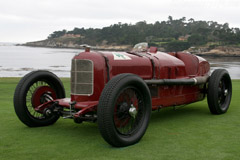 During the 1924 French Grand Prix the Bugatti Type 35 made its international racing debut. Although it would go on to become the most successful racing car ever constructed, it was thoroughly outpaced by the equally new Alfa Romeo P2. The two Alfa Romeos looked set to take a one-two win in the world-class field until Antonio Ascari's engine broke with three laps to go. His team-mate Giuseppe Campari held on to record Alfa Romeo's first win in a major Grand Prix. The P2 continued to dominate and Alfa Romeo became the very first World Champion in 1925. Although no longer eligible for the international events, the Grand Prix car was raced for several more seasons, scoring a further ten wins. The crowning win came in 1930 when Achille Varzi added the Targa Florio to the Alfa Romeo's tally. Responsible for the design of the brilliant racer was Vittorio Jano, who had been lured from rivals Fiat by a young Enzo Ferrari. The P2 used a twin-cam, supercharged straight-eight engine installed in a very light but sturdy frame. Today two examples still exist and we have taken a closer look at the Grand Prix version that is still owned by Alfa Romeo.
During the 1924 French Grand Prix the Bugatti Type 35 made its international racing debut. Although it would go on to become the most successful racing car ever constructed, it was thoroughly outpaced by the equally new Alfa Romeo P2. The two Alfa Romeos looked set to take a one-two win in the world-class field until Antonio Ascari's engine broke with three laps to go. His team-mate Giuseppe Campari held on to record Alfa Romeo's first win in a major Grand Prix. The P2 continued to dominate and Alfa Romeo became the very first World Champion in 1925. Although no longer eligible for the international events, the Grand Prix car was raced for several more seasons, scoring a further ten wins. The crowning win came in 1930 when Achille Varzi added the Targa Florio to the Alfa Romeo's tally. Responsible for the design of the brilliant racer was Vittorio Jano, who had been lured from rivals Fiat by a young Enzo Ferrari. The P2 used a twin-cam, supercharged straight-eight engine installed in a very light but sturdy frame. Today two examples still exist and we have taken a closer look at the Grand Prix version that is still owned by Alfa Romeo.The Alfa Romeo P2 feature also serves as the introduction of our heavily revised 'Major Wins' section in the cars' spec tables. As you'll be able to see you can click on the years and races to get the results for that season or event over the years respectively. It is still very much a work in progress and the results' database is still growing rapidly. Both Volvo and Renault revealed teasers this week of upcoming models. The clearest are the first pictures of the all new Volvo S60, which is set to debut during next year's Geneva Motor Show. On the 25th of this month Renault will revive the legendary Gordini brand with the introduction of the Twingo Gordini RS. The picture supplied only reveals the wheels but rest assured, the car will be bright blue. A Gordini version of the Clio and Megane will follow in due time. At the recent SEMA Show, American tuner Lingenfelter had a go at bringing back another legendary machine; the Pontiac Trans Am. Using a 2010 Camaro as a donor they created the 455 T/A Concept. Its retro looks are backed up by a 655 bhp V8. |
|
2009-11-09: Sir Stirling's OSCA, Australia's Skelta sports cars come to Europe and BMW's X6 hybrid ...
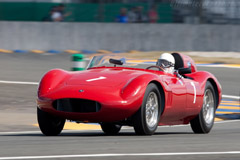 Every year, all major events celebrate a wide variety of anniversaries. This year was no exception as the 80th birthday of Sir Stirling Moss was celebrated on both sides of the Atlantic. At the Goodwood Revival Meeting, he was honoured with a parade of 80 cars he piloted during his highly successful career. Sir Stirling is still racing himself and at the Revival he campaigned his recently acquired OSCA FS 372 Morelli Spider. This is very fitting as Moss recorded one of his greatest victories, the 1954 Sebring 12 Hours, in an OSCA against competition propelled by engines many times the size of the diminutive OSCA 'four'. The FS 372 is of a slightly later vintage and represents the ultimate development of the four-cylinder OSCA sports racers. Only five were built and at least one was fitted with 'desmodromic' valve actuation. Moss' car is currently also fitted an engine of this type. Beautifully prepared by Hall & Hall, the small OSCA was raced in Sir Stirling's laid-back style at several events this year, including the 24 Hours of Le Mans support event and during the Goodwood Revival. The FS 372 is pictured at both these occasions.
Every year, all major events celebrate a wide variety of anniversaries. This year was no exception as the 80th birthday of Sir Stirling Moss was celebrated on both sides of the Atlantic. At the Goodwood Revival Meeting, he was honoured with a parade of 80 cars he piloted during his highly successful career. Sir Stirling is still racing himself and at the Revival he campaigned his recently acquired OSCA FS 372 Morelli Spider. This is very fitting as Moss recorded one of his greatest victories, the 1954 Sebring 12 Hours, in an OSCA against competition propelled by engines many times the size of the diminutive OSCA 'four'. The FS 372 is of a slightly later vintage and represents the ultimate development of the four-cylinder OSCA sports racers. Only five were built and at least one was fitted with 'desmodromic' valve actuation. Moss' car is currently also fitted an engine of this type. Beautifully prepared by Hall & Hall, the small OSCA was raced in Sir Stirling's laid-back style at several events this year, including the 24 Hours of Le Mans support event and during the Goodwood Revival. The FS 372 is pictured at both these occasions.In recent years Australian racing saw the arrival of the unusually styled Skelta sports cars. It is now Europe's turn to welcome the Skelta G-Force and Spyder. The track-oriented machines are built from lightweight materials around a sturdy chrome-molybdenum spaceframe. The styling is dictated by aerodynamics and creates 200kg of downforce at 90mph. There is a choice of engines between a supercharged Honda S2000 'four' and an exceptionally light Hartley V8 that produces well in excess of 400 bhp. BMW today revealed the first details of the ActiveHybrid X6. Its twin-turbo V8 engine and two electric motors produce a combined 485 bhp and 780 Nm of torque. When only a fraction of that power is required the 'Sports Activity Coup�' can also run on the two electric motors alone. The ActiveHybrid can accelerate to 60 mph in just 5.6 seconds but still gets a decent mileage and relatively low CO2 emissions. |
2009-11-05: New lightweight specials from Porsche and BMW ...
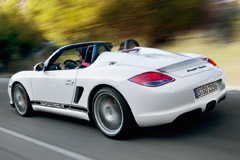 At next month's Los Angeles Motor Show, Porsche will reveal this Boxster Spyder. Based on the current Boxster S model, the new Spyder is a tribute to Porsche's legendary racing cars from the 1950s like the 550 RS Spyder from 1955 or the 718 RS 60 Spyder built five years later. The most obvious visual change on the 2010 Spyder is the rear deck, which sports two bumps instead of the fold-down roof found on the regular production model. In the spirit of the early racing cars, a very rudimentary cloth roof can be used but it only offers minimal weather protection. The interior is equipped with the bare minimum and includes racing touches like the straps to open the doors. Performance is also up compared to the standard Boxster courtesy of a considerable drop in the weight and an additional 10 bhp from the direct injection flat six. The Boxster Spyder will be available from February 2010.
At next month's Los Angeles Motor Show, Porsche will reveal this Boxster Spyder. Based on the current Boxster S model, the new Spyder is a tribute to Porsche's legendary racing cars from the 1950s like the 550 RS Spyder from 1955 or the 718 RS 60 Spyder built five years later. The most obvious visual change on the 2010 Spyder is the rear deck, which sports two bumps instead of the fold-down roof found on the regular production model. In the spirit of the early racing cars, a very rudimentary cloth roof can be used but it only offers minimal weather protection. The interior is equipped with the bare minimum and includes racing touches like the straps to open the doors. Performance is also up compared to the standard Boxster courtesy of a considerable drop in the weight and an additional 10 bhp from the direct injection flat six. The Boxster Spyder will be available from February 2010.BMW also revealed the first details of a special, lightweight edition of one of their current models today. Dubbed the M3 GTS, the new BMW is even more extreme than the aforementioned Porsche. The GTS features a completely stripped interior, a larger and more powerful engine and an aggressive body-kit. The most fundamental change is the introduction of a 4.4 litre version of the highly acclaimed M3 V8. It produces 450 bhp, which is transferred to the rear wheels through a seven-speed, dual-clutch gearbox. Weight is down to 1490 kg or 3285 lbs. According to BMW the car is suited for use on the road but can also be campaigned on track, in 'Clubsport' events. The M3 GTS may also serve to homologate new bits for the M3 GTR GT2 racer that is expected to feature more prominently on the world's racing tracks in 2010. |
|
2009-11-04: Chevrolet, Dodge and Ford highlights from SEMA and two updated classics ...
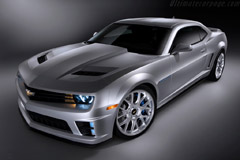 Yesterday the annual aftermarket extravaganza, the Speciality Equipment Manufacturers Association Show (SEMA Show), opened its doors in Las Vegas, Nevada. The major manufacturers traditionally also have a strong presence on the floor to showcase their aftermarket bits on specifically created show cars. Although slightly more modest, the big three were once again well represented in Las Vegas. Today we take a look at three of their best offerings.
Yesterday the annual aftermarket extravaganza, the Speciality Equipment Manufacturers Association Show (SEMA Show), opened its doors in Las Vegas, Nevada. The major manufacturers traditionally also have a strong presence on the floor to showcase their aftermarket bits on specifically created show cars. Although slightly more modest, the big three were once again well represented in Las Vegas. Today we take a look at three of their best offerings.General Motors brought out various Camaro based concepts. Our favourite was this Camaro Jay Leno Concept, built for the Late Night Talk Show Host it is named after. It is powered by a twin-turbocharged version of the direct injection V6 found in the base model. The turbos have lifted the power to a commendable 425 bhp but the engine is nevertheless capable of very frugal driving. Needless to say, it also sports a more aggressive body-kit. Both Ford and Chrysler presented drag-racing inspired machinery. The special Mustang FR500 Cobra Jet on display provides a preview of the upcoming 50-car production run of the Mustang drag-racers. It is less likely that the Dodge Moper Challenger 1320 will make to the quarter-mile or 1320 feet strips. Every time we go out to visit events we expand our archives with more photography and quite often we get new opportunities to shoot cars that have already been featured on Ultimatecarpage.com. This week we have updated our features on two great cars with some of the new material. The first is the Lancia D24, which one of the great sports racers of its day. It was particularly successful in the great road races, taking the outright victory in the Carrera Panamericana, Targa Florio and Mille Miglia. The pictured example is one of two survivors and the only one in private hands. Where the Lancia was the last of the line, the M19A brought McLaren back to their winning ways in 1972. We first saw Denny Hulme's South African Grand Prix winner at the 2006 Monaco Historic Grand Prix where it was damaged in an accident. Fortunately, it was fully repaired two years later so we had another opportunity to shoot the successful Formula 1 racer. |
2009-11-02: 1956 World Sportscar Championship winning Ferraris ...
 During the mid-1950s Ferrari experimented with a wide variety of engines in the company's sports racer, including straight fours and sixes. For the Italian manufacturer's assault on the 1956 World Championship, Ferrari settled on using virtually identical four and twelve cylinder engined machines. Both cars shared the exact same chassis and a similarly styled, Scaglietti built aluminium body.
During the mid-1950s Ferrari experimented with a wide variety of engines in the company's sports racer, including straight fours and sixes. For the Italian manufacturer's assault on the 1956 World Championship, Ferrari settled on using virtually identical four and twelve cylinder engined machines. Both cars shared the exact same chassis and a similarly styled, Scaglietti built aluminium body.The more successful of the two was the V12-engined 290 MM, which was driven to a debut victory in the Mille Miglia by Eugenio Castellotti. The great Juan Manuel Fangio finished fourth behind two of the four cylinder engined cars in another 290 MM. Later in the year Phil Hill and Maurice Trintignant added a second win to the 290 MM's tally in only its third major race. The final World Championship win for the 3.5 litre sports racer came early in 1957 during the Buenos Aires 1000 km race. Three examples were originally built and one of the four cylinder engined cars was later converted to V12 specification. All three cars that have survived are featured in our detailed article. Among them are the cars driven to victory in the Mille Miglia and the Buenos Aires 1000 km. The sister 860 Monza had an equally impressive first outing, with a one-two victory in the 1956 Sebring 12 Hours. During the remainder of the season, the big fours supported Ferrari's chase for the championship with valuable podium finishes. With three very convincing wins in the five rounds, Ferrari was deservedly crowned World Champion at the end of the 1956 season. We caught up with the Sebring winning example some years ago at the Concorso d'Eleganza Villa d'Este where we snapped this 12-shot gallery. |
| All Cars - Contact us - Privacy Statement - Top | © 1998 - 2024 Ultimatecarpage.com |

